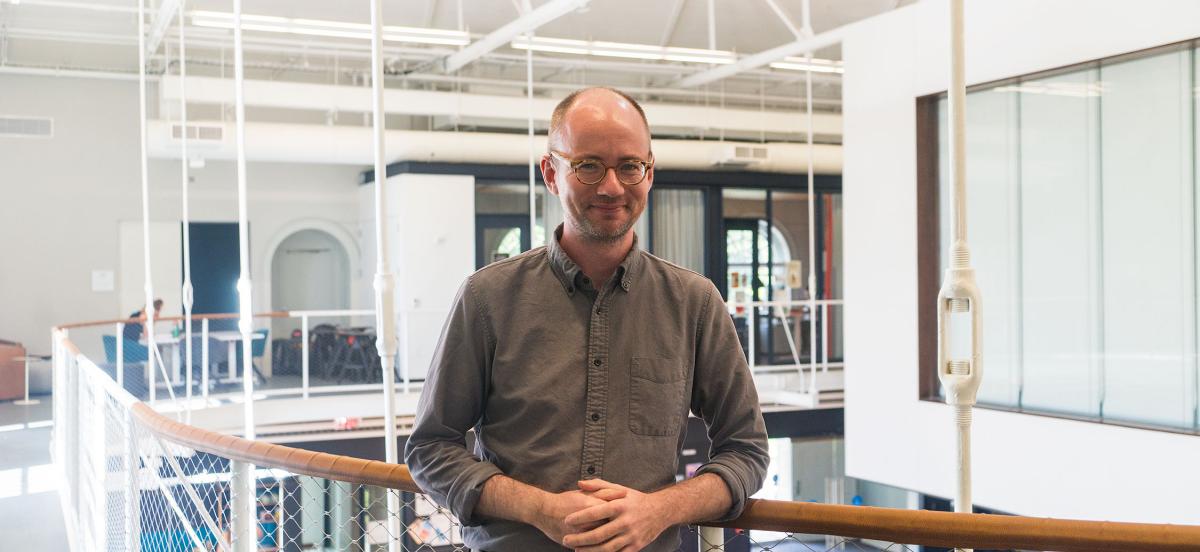A View of VCAM from the Inside

James Weissinger '06, associate director of the John B. Hurford '60 Center for the Arts and Humanities and operations manager for VCAM, in the new building. Photo by Patrick Montero.
Details
James Weissinger '06, associate director of the John B. Hurford '60 Center for the Arts and Humanities and operations manager for VCAM, discusses the newest campus building and his hopes for its future.
This fall, Haverford opened a new space for visual culture, arts, and media (VCAM) in the Old Gym in the center of campus. James Weissinger '06, associate director of the John B. Hurford '60 Center for the Arts and Humanities and operations manager for VCAM, has been a leading member of the project since its inception. He has been working for several years with VCAM Director Laura McGrane, architects from MSR Design, and members of the Haverford community to bring the dream of this new space to life. We sat down with James to talk about his hopes for the building's future.
Haverford College: What are you most excited about with the opening of VCAM?
James Weissinger: There’s a way in which VCAM will scratch a lot of itches we already have. We already have students making fantastic films; we have visiting artists here all the time making great projects; we have faculty teaching challenging new courses in visual studies; we have students getting interested in staging their own exhibition projects. So that’s been going on for a bit through the Hurford Center and through other entities on campus, but we often haven’t had the proper facilities for them up to this point. People have made do—it’s been very DIY—but now there are proper facilities in VCAM to do those things. We have an artist residency studio. We have Create Spaces, where students can stage exhibition projects. We have the gorgeous screening room, which is the gem of the building. And then there are things that the campus has needed for a while, like a central community gathering space right in the middle of campus, which I’ve wanted to have even since I was a student. So that addresses challenges we’ve had for a while.
I think what will be really interesting, though, is that once we’ve satisfied those desires, if VCAM works correctly, it will produce new desires. It will draw in new collaborators from all different departments and corners of campus who might not have thought, “I’m interested in visual studies.” So I think VCAM expands on the interdisciplinary mission of all three academic centers, which all do different things, but perhaps one similar thing in that they bring folks together from different departments and different programs to collaborate: students, staff, and faculty.
HC: What, specifically, do you think the VCAM building will bring to campus that we haven’t had before?
JW: There’s been a culture of students and faculty and staff interested in making and in fabrication in different pockets across campus. Having a central arts space with a new staff member, Kent Watson, dedicated to running that space, with the 3D printers and the CNC routers and the equipment there is going to be pretty new. It’s also going to be a classroom, so it’s somewhere that computer science classes might be taught, but also somewhere that sculpture classes or anthropology classes can take place. It’ll be interesting to see how the space functions as a classroom, as a space facilitated by VCAM student monitors in the evenings, and something that draws in students and faculty from a pretty diverse set of departments and programs.
HC: What are your personal hopes for VCAM? You’ve poured so much into it and you’ve been one of the main people making it happen—what are you hoping will happen from here?
JW: Haverford’s small size necessitates a feedback loop between the curriculum and what’s outside the curriculum. When that’s working correctly, it can be very powerful and exciting, and the Hurford’s student-centered programming—the reading groups and student seminars—have hovered in that spot, in that they’re often connected to the curriculum while still remaining outside it. That model works broadly for the arts at Haverford. Everyone engages with the arts in some way while they’re here: maybe they major in fine arts or music; maybe they go on a Dialogues on Art trip downtown, maybe they stage a performance through the E. Clyde Lutton Memorial Fund for Performance, maybe they work in the Hurford Center’s Cantor Fitzgerald Gallery. VCAM is going to provide even more of those touchpoints for students to get involved. What’s new and exciting is that for certain artistic practices—and I’m thinking particularly about film—for students who want to make this a central part of their lives, they’re going to have the facilities and tools to do that, to make those projects, but also to share them in a very professional way. I’m excited to see how that film activity works in tandem with the new visual studies program, now that we have all of these new resources.



